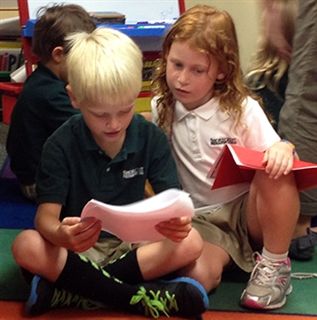

Resourceful, Flexible and Creative Students
Source/Author: Adrianne Finley Greenlees, Asst Headmaster for Advancement & Strategic Planning
September 25, 2014
Last week I had the wonderful opportunity to see several of our Lower School teachers in action. I witnessed teaching that fostered curiosity and creativity and encouraged children to take risks. According to Yong Zhao in the book World Class Learners, this type of education is ideal for cultivating creativity and innovative thinking in our young people. Zhao makes a strong case for an educational system that encourages curiosity, creativity, and risk-taking versus the traditional Chinese system that stresses learning factual information and skills to perform well on a test.
You may have seen the recent news reports about how Chinese students outperform every other country on the PISA test (Program for International Student Assessment). Some news media have latched on to these reports, sending out an alarmist message about the decline of American education and making the case for modifying American education to better prepare our students to perform on this international assessment. Dr. Zhao writes that the reason Chinese students do so well on these and other tests is that test-taking has become the sole focus of their education. For example, the typical Chinese elementary school student spends ten hours a day in her studies, leaving no room for any activities beyond academic ones. The emphasis on performing well on the tests drives conformity of curriculum as well as a high-pressure environment for students with no room for creativity or risk-taking.
Zhao writes, “When one is taught to conform, it will be difficult for him to be creative. When one is punished for making mistakes, it will be hard for her to take risks. When one is told to be wrong or inadequate all the time, it will be difficult for her to maintain confidence.”
He goes on to explain that the “side effect” of an education system that focuses on preparing students for success on tests is a society that produces fewer entrepreneurs, less innovation, and a lack of creative thinking that is desperately needed to address the challenges of our world today.
He goes on to explain that the “side effect” of an education system that focuses on preparing students for success on tests is a society that produces fewer entrepreneurs, less innovation, and a lack of creative thinking that is desperately needed to address the challenges of our world today.
Last week in the Lower School, I witnessed teachers who were dedicated to encouraging their students to really think, to work through problems both individually and in teams, to take risks by presenting their work to their fellow classmates, and to build on their strengths and address their weaknesses in a productive way. The “side effect” of this kind of instruction is creativity, something that can be found in great measure throughout all of Shorecrest.
In first grade, Ms. Hawley praised her students by declaring, “Last week, I was watching you and I noticed something very special that some of you were doing. I noticed a few of you were doing something famous writers do.” What encouragement! Imagine if we all had such encouragement every day of our lives, and how it might inspire us to take more risks and find creative approaches to our tasks at hand.
























